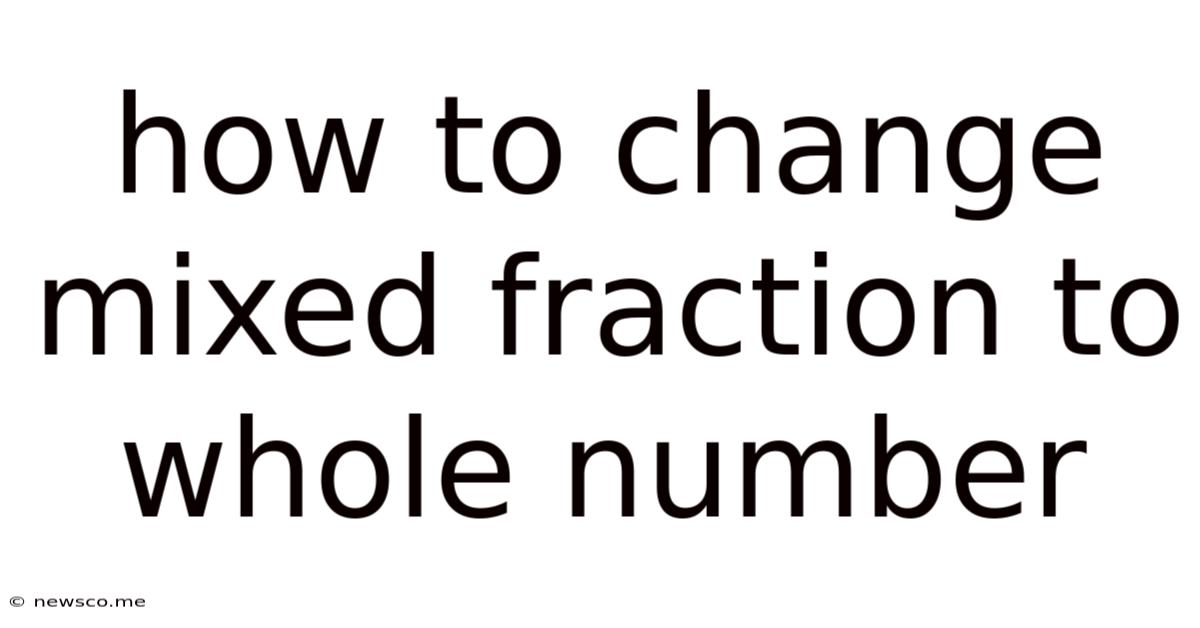How To Change Mixed Fraction To Whole Number
News Co
Apr 13, 2025 · 5 min read

Table of Contents
How to Change Mixed Fractions to Whole Numbers: A Comprehensive Guide
Converting a mixed fraction to a whole number isn't always possible. A mixed fraction, by definition, contains a whole number part and a fractional part. To become a whole number, the fractional part must be zero. However, we can convert a mixed fraction into an improper fraction, which can then be used in calculations more easily. This guide will explore different approaches, clarifying the scenarios where conversion to a whole number is possible and explaining the more general process of transforming mixed fractions into improper fractions.
Understanding Mixed Fractions and Whole Numbers
Before diving into the conversion process, let's refresh our understanding of the terms involved.
-
Whole Number: A whole number is a non-negative number without any fractional or decimal part. Examples include 0, 1, 2, 3, and so on.
-
Fraction: A fraction represents a part of a whole. It's expressed as a ratio of two numbers: the numerator (top number) and the denominator (bottom number). For example, 1/2 (one-half), 3/4 (three-quarters).
-
Mixed Fraction: A mixed fraction combines a whole number and a fraction. For example, 2 1/2 (two and one-half), 3 3/4 (three and three-quarters). This represents a quantity larger than one whole unit.
-
Improper Fraction: An improper fraction has a numerator that is greater than or equal to its denominator. For instance, 5/2 (five-halves), 7/4 (seven-quarters). These fractions represent values equal to or greater than one.
When Can a Mixed Fraction Be Converted to a Whole Number?
A mixed fraction can only be converted to a whole number if its fractional part is zero. In other words, the numerator of the fractional part must be zero. This means that the original mixed fraction already represents a whole number. For example:
- 2 0/5 can be simplified directly to 2.
In all other cases, the mixed fraction cannot be directly converted to a whole number. We need to work with the improper fraction equivalent.
Converting a Mixed Fraction to an Improper Fraction
This is the crucial step for most operations involving mixed fractions. The process involves the following steps:
-
Multiply the whole number by the denominator: Take the whole number part of the mixed fraction and multiply it by the denominator of the fractional part.
-
Add the numerator: Add the result from step 1 to the numerator of the fractional part.
-
Keep the denominator: The denominator of the improper fraction remains the same as the denominator of the original fractional part.
Let's illustrate with an example: Convert the mixed fraction 3 2/5 to an improper fraction.
-
3 (whole number) x 5 (denominator) = 15
-
15 (result) + 2 (numerator) = 17
-
The denominator remains 5.
Therefore, the improper fraction equivalent of 3 2/5 is 17/5.
Practical Applications and Examples
Let's work through several examples to solidify our understanding:
Example 1: Convert 5 1/4 to an improper fraction.
- 5 x 4 = 20
- 20 + 1 = 21
- Denominator remains 4.
Therefore, 5 1/4 is equivalent to 21/4.
Example 2: Convert 1 3/8 to an improper fraction.
- 1 x 8 = 8
- 8 + 3 = 11
- Denominator remains 8.
Therefore, 1 3/8 is equivalent to 11/8.
Example 3: Convert 2 7/10 to an improper fraction.
- 2 x 10 = 20
- 20 + 7 = 27
- Denominator remains 10.
Therefore, 2 7/10 is equivalent to 27/10.
Using Improper Fractions in Calculations
Improper fractions are essential for various mathematical operations. They simplify calculations considerably compared to working directly with mixed fractions. For example:
-
Addition and Subtraction: It's easier to add or subtract fractions when they have a common denominator. Converting to improper fractions often makes finding a common denominator simpler.
-
Multiplication and Division: Multiplying and dividing mixed fractions is significantly more straightforward when converted to improper fractions first.
-
Solving Equations: In algebraic equations, using improper fractions avoids the complexities of dealing with both whole numbers and fractions simultaneously.
Advanced Techniques and Considerations
While the method above is the most common, there are other approaches:
Using Visual Representations: For smaller mixed numbers, a visual approach using diagrams (like circles or rectangles representing the wholes and fractional parts) can aid understanding. This helps visualize the concept of combining wholes and fractions to represent them as a single, larger fraction.
Mental Math Strategies: With practice, you can develop mental math skills to convert mixed fractions to improper fractions quickly. For example, recognizing that 2 1/2 is (2 x 2 + 1) / 2 = 5/2 can speed up calculations.
Avoiding Common Errors: A common error is forgetting to add the numerator after multiplying the whole number by the denominator. Always double-check your calculations to prevent mistakes.
Conclusion
While a direct conversion of a mixed fraction to a whole number is only possible when the fractional part is zero, converting to an improper fraction is a vital skill for simplifying mathematical operations. Mastering this conversion is key to working confidently with fractions and solving a wide range of mathematical problems. Practice various examples, use visual aids if needed, and focus on understanding the underlying principles to ensure accuracy and efficiency. Remember to always check your work for any potential errors to maintain accuracy in your calculations.
Latest Posts
Related Post
Thank you for visiting our website which covers about How To Change Mixed Fraction To Whole Number . We hope the information provided has been useful to you. Feel free to contact us if you have any questions or need further assistance. See you next time and don't miss to bookmark.